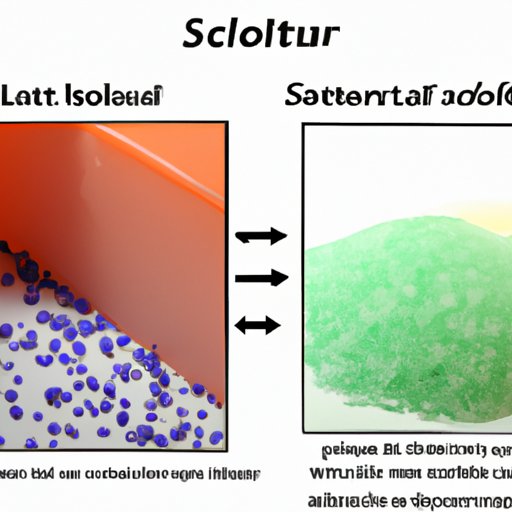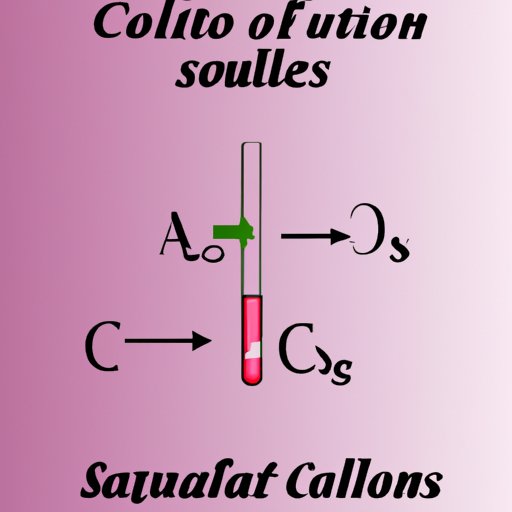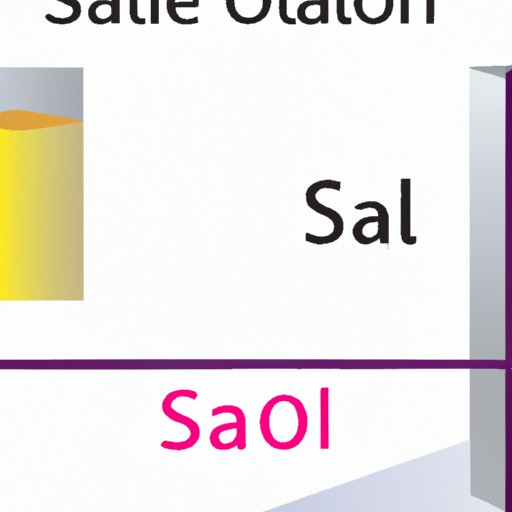Introduction
In science, the term “solute” is used to refer to a substance that has been dissolved in a solution. This term is used in a variety of fields, including chemistry and physics, and it has an important role in understanding the behavior of different substances in different environments. To better understand solutes and the science behind them, let’s take a closer look at what this term means and how it applies to our everyday lives.
Exploring the Science Behind Solutes: What Does This Term Mean?
At its most basic level, a solute is a substance that has been dissolved in a solution. The solute can be a solid, liquid, or gas, and when it is added to the solution, it will dissolve into the solvent (the substance in which the solute is being dissolved). For example, when sugar is added to water, it will dissolve and become part of the solution.
In chemistry, solutes play an important role in understanding how different substances interact with each other. When two substances are combined, the solute will be attracted to the solvent molecules and form bonds with them. This process is known as solvation, and it is essential for many chemical reactions. By understanding the interactions between solutes and solvents, scientists can better predict the outcomes of different reactions.
Solute is also used to describe the concentration of a particular substance in a solution. Generally, the higher the concentration of the solute, the more intense the reaction. For example, if you add more sugar to water, the sweetness of the solution will increase.
Solute can also be found in everyday life. Common examples include salt in seawater, sugar in tea, and carbon dioxide in soda. In all of these cases, the solute is dissolved in the solvent and affects the properties of the solution.
A Comprehensive Guide to Understanding Solute in Science
When it comes to understanding solutes in science, there are several key concepts that need to be explored. First, it’s important to understand the different types of solutes and how they interact with other particles. Second, it’s important to understand how solutes are measured and quantified. Finally, it’s important to understand the importance of solutes in chemical reactions.
The Different Types of Solutes
There are several different types of solutes, each of which behaves differently when added to a solution. These include:
- Ionic solutes: These are solutes that contain charged particles, such as sodium chloride (table salt). When ionic solutes are dissolved in water, they will break apart into ions and form electrolytes.
- Molecular solutes: These are solutes that contain molecules, such as sugar or ethanol. When molecular solutes are dissolved in water, they will break apart into individual molecules.
- Gaseous solutes: These are solutes that are gases, such as oxygen or carbon dioxide. When gaseous solutes are dissolved in water, they will mix throughout the solution and form bubbles.
How Solutes are Measured and Quantified
In order to measure and quantify solutes, scientists use a variety of tools and techniques. One of the most common methods is chromatography, which involves separating a mixture of solutes and solvents using a column filled with a stationary phase. The solutes will move through the column at different rates, allowing scientists to measure the concentration of each solute in the mixture.
Another method for measuring and quantifying solutes is spectroscopy, which uses light to determine the composition of a solution. This technique is often used to analyze complex mixtures, such as those found in biological samples.
The Importance of Solutes in Chemical Reactions
In addition to measuring and quantifying solutes, scientists also use solutes to control the outcome of chemical reactions. For example, by adding a solute to a solution, scientists can change the pH of the solution and alter the way the reactants interact with each other. Similarly, by changing the concentration of a solute, scientists can speed up or slow down a reaction.
Understanding the role of solutes in chemical reactions is essential for designing efficient and effective experiments. By manipulating the concentrations of solutes, scientists can ensure that their experiments yield the desired results.
The Chemistry Behind Solutes: What is a Solute and How Does it Work?
Now that we’ve explored the basics of solutes, let’s dive deeper into the chemistry behind this term. At its core, a solute is a substance that is dissolved in a solution. When a solute is added to a solution, it will dissolve into the solvent and form a homogenous mixture. This process is known as solvation and it is essential for many chemical reactions.
When a solute is dissolved in a solution, it will interact with the solvent molecules. Depending on the type of solute, these interactions can range from simple attraction to strong covalent bonds. As a result, the solute will become part of the solution and affect its physical properties.
For example, when sugar is added to water, it will dissolve into the solvent and increase the sweetness of the solution. Similarly, when salt is added to water, it will dissolve into the solvent and increase the salinity of the solution.

A Look at the Physical Properties of Solutes and Their Role in Science
Now that we’ve discussed the basics of solutes and their role in chemistry, let’s explore the physical properties of solutes and how they affect solutions. Generally speaking, solutes have a number of unique physical properties that make them useful in a variety of scientific applications.
For example, solutes tend to lower the freezing point of a solution. This property makes them useful in cryopreservation, as they can be used to keep cells and tissues alive at extremely low temperatures. Similarly, solutes can also be used to increase the boiling point of a solution, making them useful in distillation processes.
In addition to affecting the physical properties of solutions, solutes can also be used to change the concentration of a solution. By increasing or decreasing the amount of solute in a solution, scientists can increase or decrease the concentration of the solution. This process is known as dilution, and it is essential for controlling the outcome of chemical reactions.

Understanding the Function of Solutes in Chemistry Solutions
Finally, let’s take a look at how solutes can be used to control the outcome of chemical reactions. Generally speaking, solutes can be used to increase or decrease the concentration of a solution, which affects the rate at which the reactants interact with each other. By carefully controlling the concentration of a solution, scientists can ensure that their experiments yield the desired results.
For example, by increasing the concentration of a solute, scientists can speed up a reaction. Similarly, by decreasing the concentration of a solute, scientists can slow down a reaction. This process is known as concentration control, and it is essential for designing efficient and effective experiments.
Conclusion
In conclusion, solutes play an important role in the world of science. From understanding the science behind solutes to exploring the physical properties of solutes and their role in chemistry solutions, this article provides a comprehensive guide to understanding solutes in science. By understanding the functions of solutes and how they interact with other particles, scientists can better predict the outcomes of different reactions and design efficient and effective experiments.
(Note: Is this article not meeting your expectations? Do you have knowledge or insights to share? Unlock new opportunities and expand your reach by joining our authors team. Click Registration to join us and share your expertise with our readers.)
